A Brief History of Editing:
Early on cameramen would make cuts in the camera by stopping cranking at the end of a shot and cranking the camera again when it was moved somewhere else. Paul's 'Cinematograph Camera No. 1' of 1896 was the first camera to feature reverse-cranking, which allowed the same film footage to be exposed several times and thereby to create super-positions and multiple exposures. One of the first films to use this technique, Georges Méliès's The Four Troublesome Heads from 1898, was produced with Paul's camera. And In 1899-1900 multi-shot films were definitively established by George Albert Smith and James Williamson. Smith made Seen Through the Telescope, in which the main shot shows street scene with a young man tying the shoelace and then caressing the foot of his girlfriend, while an old man observes this through a telescope. There is then a cut to close shot of the hands on the girl's foot shown inside a black circular mask, and then a cut back to the continuation of the original scene. Porter worked on a number of minor films before making Life of an American Fireman in 1903. The film was the first American film with a plot, featuring action, and even a closeup of a hand pulling a fire alarm. The film comprised a continuous narrative over seven scenes, rendered in a total of nine shots.[4] He put a dissolve between every shot, just as Georges Méliès was already doing, and he frequently had the same action repeated across the dissolves. His film, The Great Train Robbery (1903), had a running time of twelve minutes, with twenty separate shots and ten different indoor and outdoor locations. He used cross-cutting editing method to show simultaneous action in different places.
Visual Analysis:
There has been a system developed which enables the audience to understand the relationship shot to shot and makes a seamless effect whilst following the action this consists of; establishing shots, 180 degree rule, shot-reverse-shot, match on action and eyeline match cuts. You can see how these have been used in the above clip with the examples I have given below.
____________________________________________________
 |
| Establishing Shot |
At 0:12 you have an establishing shot, which uses a long shot at the beginning of a sequence to show where the location is as well as the time of day, so here it is the newly brought house of the couple in the middle of the day. This shot involves the use of screen time showing the inseparable two sharing precious time together.
____________________________________________________
 |
| Eyeline Match 1 |
At 0:06 you can see a very clear example of an eyeline match, this technique shows a person looking off in one direction in the first shot, here it would be Ellie and Carl looking off to the left, and then in the second shot it shows the space containing what that person sees or a person looking back in the opposite direction, here it would be their friends and family looking back at them.
 |
| Eyeline Match 2 |
____________________________________________________
 |
| Shot-Reverse-Shot 1 |
 |
| Shot-Reverse-Shot 2 |
* this is where a scene is constructed along an axis of action once the camera takes a position in relation to this axis, it should never cross it; this is the fundamental rule of respecting spatial continuity from shot to shot
____________________________________________________
 |
| Match On Action 1 |
At 0:04 they use a match on action technique where one shot cuts to another portraying the action of the subject in the first shot, here you see it in the form of a close up as Ellie is lowering Carl as she kisses him and in the next its a medium shot of her lifting him back up whilst releasing him from the kiss. This allows the audience's attention to be drawn away from slight cutting portraying a continuous sense of a single action rather than two.
 |
| Match On Action 2 |
This involves use of close-ups which is important for the viewer to make them more involved as not only will the be able to see the details of this person and the emotions they may be showing but the viewer is drawn into the subject's personal space and shares their feelings making them feel more connected.
_________________________________________________________________________
When generating appropriate involvement in the story line, pace, tension and suspense of a film you have to keep the audience interested in the main protagonist and to do this you have to make interesting things happen to them. Another thing to assist with this are the following editing techniques: shot variation, montage, providing and withholding information, parallel editing/ cross-cutting, editing rhythm, construction of the 'time' and 'space' of the story (diegetically & implied), cutting to soundtrack, multiple points of view, cutaway and jump-cuts.
By using shot variation the tone of the scene is set which lets the audience understand, usually very quickly, the concept of the scene. By using different shots throughout a film it enables you to get an understanding of your surroundings (long shots can achieve this) or even emotions the protagonist is portraying (close ups and medium shots can connote this), Disney Pixar's Up uses shot variation throughout the film and I believe it successfully depicts exactly what is intended for each shot.
In Shot 1 the use of a medium shot allows you to see the shock and disappointment on Carl's face as he makes an innocent mistake whilst simultaneously showing Ellie's surprised but still blissful expression. By doing this it shows the audience the love they have for one another as Carl tries his best to make everything perfect for Ellie and she is delighted about the effort he puts in despite any small mistakes made showing that within a singular shot you are able to progress the story line dramatically.
In shot 2 and shot 3 you are able to see, in this order, a close up and a long shot of the plans of the house they are to build together and the completed house. not only does this set the scene but this also develops the characters, and ultimately the story line, showing how hard they have worked for their shared dream.
They also used a montage of Carl and Ellie to show them overcoming hardships and growing old together further developing their story and keeping the audience interested with a variation of scenes that show a wide range of the protagonists emotions. The collection of clips played together generates suspense and excitement for the audience as they are left wondering what is going to happen next and as a lot of these show close-ups you feel very involved as if you went on the journey with them.
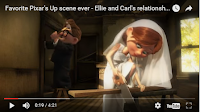
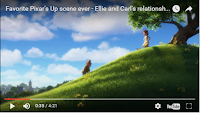
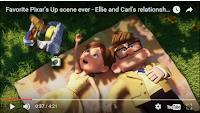
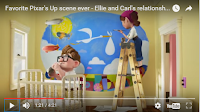


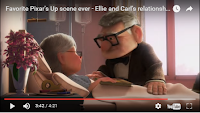
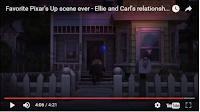
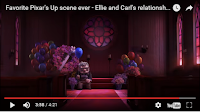
When generating appropriate involvement in the story line, pace, tension and suspense of a film you have to keep the audience interested in the main protagonist and to do this you have to make interesting things happen to them. Another thing to assist with this are the following editing techniques: shot variation, montage, providing and withholding information, parallel editing/ cross-cutting, editing rhythm, construction of the 'time' and 'space' of the story (diegetically & implied), cutting to soundtrack, multiple points of view, cutaway and jump-cuts.
 |
| Shot 1 |
 |
| Shot 2 |
 |
| Shot 3 |
They also used a montage of Carl and Ellie to show them overcoming hardships and growing old together further developing their story and keeping the audience interested with a variation of scenes that show a wide range of the protagonists emotions. The collection of clips played together generates suspense and excitement for the audience as they are left wondering what is going to happen next and as a lot of these show close-ups you feel very involved as if you went on the journey with them.









No comments:
Post a Comment